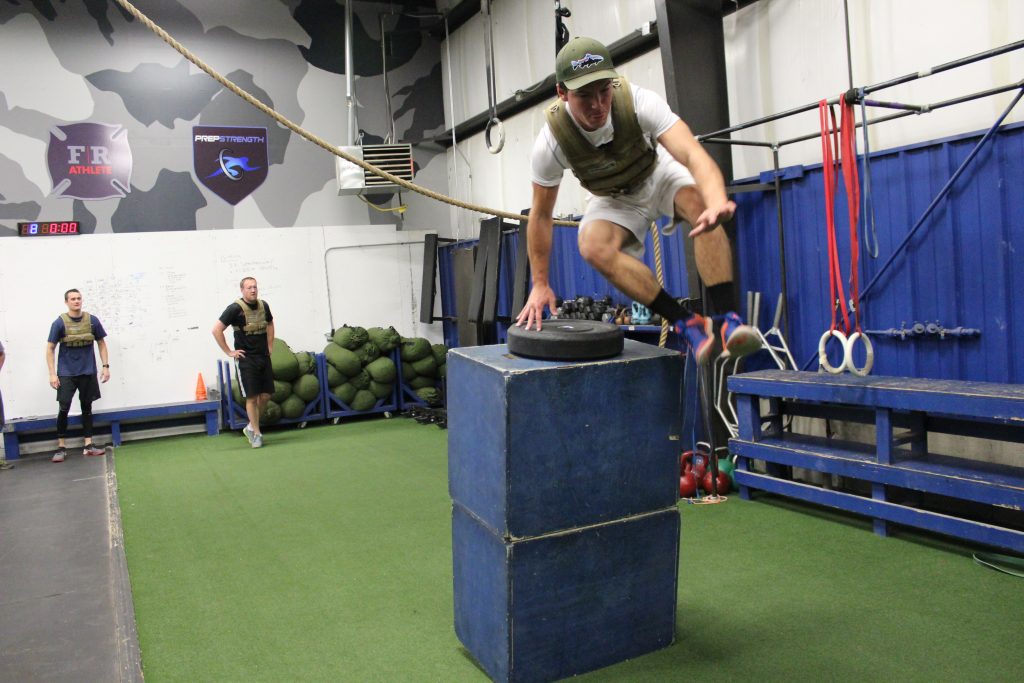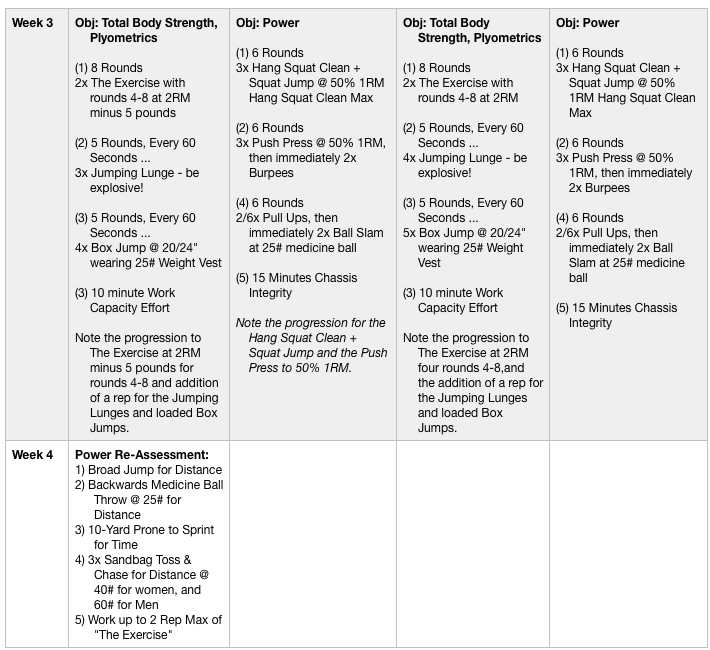
By Rob Shaul
This week MTI Lab Rats began a 4-week “geek cycle” designed to test both “explosive power” assessments and training progressions.
By “Explosive Power” we mean explosive power demonstrated in a single explosive movement or short-duration series of the same movements.
In the strength and conditioning world, another way to consider power is on the endurance side, where rowing and cycling coaches use power meets on ergs or bikes to assess and progress an athletes endurance programming.
This cycle isn’t focused on these longer efforts, but rather is focused on “explosive power.” Think a power clean, snatch, high box jump or short sprint.
Background
Early on in MTI programming, I followed standardized strength and conditioning terminology referred to Olympic lifts programmed into training sessions as “power.” But I soon moved from describing this work as training “power” to training “total body strength.”
The main reason was trouble I had identifying where “power” left off, and strength training started.
Measured in wattage, the power equation includes the barbell weight, barbells, speed, and distance traveled. Before I started my own gym I traveled to LA and attended a coach’s mentorship at the Athletes’ Performance (now Exos) facility there. Athletes’ Performance had all the latest training gadgets, including expensive Keiser weight lifting racks which used air pressure to load barbells, and meters which measure load, distance and barbell speed, and spit out the resulting power.
The coaches said they used the power-measuring capabilities of the Keiser machines to assess athlete’s power output – not on a single movement, but rather on a series of movements such as 5x front squats at 95 pounds for time. To my knowledge, however, they didn’t use power as it’s own progression metric.
However, without a Keiser machine, or another way to measure power, coming up with wattage is difficult and exact.
A 2007 study found that peak power (speed x distance x time) is generated when athletes move about 30% of the 1 rep max load for a barbell strength exercise as fast as possible. This 30% of 1RM loading has been used by coaches for years as the starting point for training explosive power in the weight room.
Another study, from 1992, found that training both strength and plyometrics together, had the greatest impact on improving one measure of explosive power, the vertical jump. overtraining just strength or training just plyometrics. The programming for this study split strength training from plyometric training. Training the two together, in the same circuit, has been a feature of MTI’s TLU Strength Training Progression for several years.
We call this “complex training” – where we’ll follow a heavy set of a specific barbell exercise immediately with a fast, explosive, bodyweight plyometric exercise which uses the same muscles and movement patterns. For example, 5x Heavy Back Squats followed immediately by 2x Box Jumps (unloaded), or a set of 4x Heavy Bench Presses followed immediately by 2x clapping push ups.
While MTI programming has deployed power, and especially, complex training, for years, to this point I had never designed a specific power cycle.
Assessing Explosive Power
We work hard in our programming to use assessments and tools which can easily be repeated elsewhere. The trick for this cycle was identifying the easily repeatable assessments for explosive power. After some experimentation, I identified 5 Power Assessments, each with its strengths and weaknesses
(1) Broad Jump for Distance
Simple assessment, but it could be heavily influenced by athlete familiarity and technique training. For the assessment, each athlete got 1x practice jump, then three official “trials.” The longest trial jump was used as the athlete’s assessment distance.
(2) Backwards Medicine Ball Throw @ 25# Medicine ball
I have my doubts about this assessment, but I’ve seen is deployed by other strength coaches, and now by the Army for the new ACFT and the Air Force for some of their Tier 2 SOF fitness assessments. Like the broad jump, I suspect an athlete’s performance on this assessment could be greatly influenced not by increased “power” but by familiarity with the event and better technique.
(3) 10-yard Prone to Sprint for Time
This is a unique power assessment to MTI which I feel perhaps has the most practical transfer to a tactical athlete. Specifically, the ability to powerfully pop up off the ground from prone and explosively move quickly for a short distance. The practical application of this ability could be quick movement when under fire, or quickly closing the distance on a perpetrator or enemy soldier.
(4) 3x Sandbag Toss & Chase for Distance @ 40# for women, and 60# for Men
I’ve used a similar assessment before in our law enforcement training but narrowed down the event, and tightened up the assessment for this cycle. What I like about the Sandbag Toss & Chase from a power perspective is it involves two total body power movements – first a power clean from the ground to the chest, and next a push press forward for distance. This relatively light loading (60#) for men seems about right – heavy enough to be challenging, but light enough to move explosively.
Cycle Design
In designing this cycle I wanted to avoid “training to the test.”. The only time the lab rats will do a broad jump for distance, backwards medicine ball throw, 10-yard prone to sprint for time, or 3x sandbag toss and chase for distance is for the initial assessment, and the final assessment.
The cycle also deploys 1RM assessment for the Hang Squat Clean and Push Press, and follow on complex training using 30/40/50% of these maxes and bodyweight exercises. It also deploys a body-weight pull up followed by ball slam circuit to train (hopefully) upper body pulling explosive power. I do modify the hang squat clean for the progression, but adding a squat jump with the barbell for each rep. See the clip below …
Finally, the cycle deploys simple plyometric training. Specifically, jumping lung intervals, and loaded box jump intervals using a weight vest. See the chart below for the progression:


Final thoughts Before the Results
I’m hoping to see across the board improvement on the assessments at the end of the cycle, but am not sure – esp. for the backwards medicine ball throw and I suspect that event is technique, rather than power, dependent.
Based on the conventional theory, my lab rats should see improvements in the broad jump for sure, and hopefully in the 10-yard prone-to-sprint.
More to follow in a couple of weeks!
Questions, Comments, Feedback? Email rob@mtntactical.com
You Might Also Like “Geek Cycle” Researching Working Strength Progression, Work Capacity Power Production, Endurance Mode Transfer and Hang Board Interval Protocols
